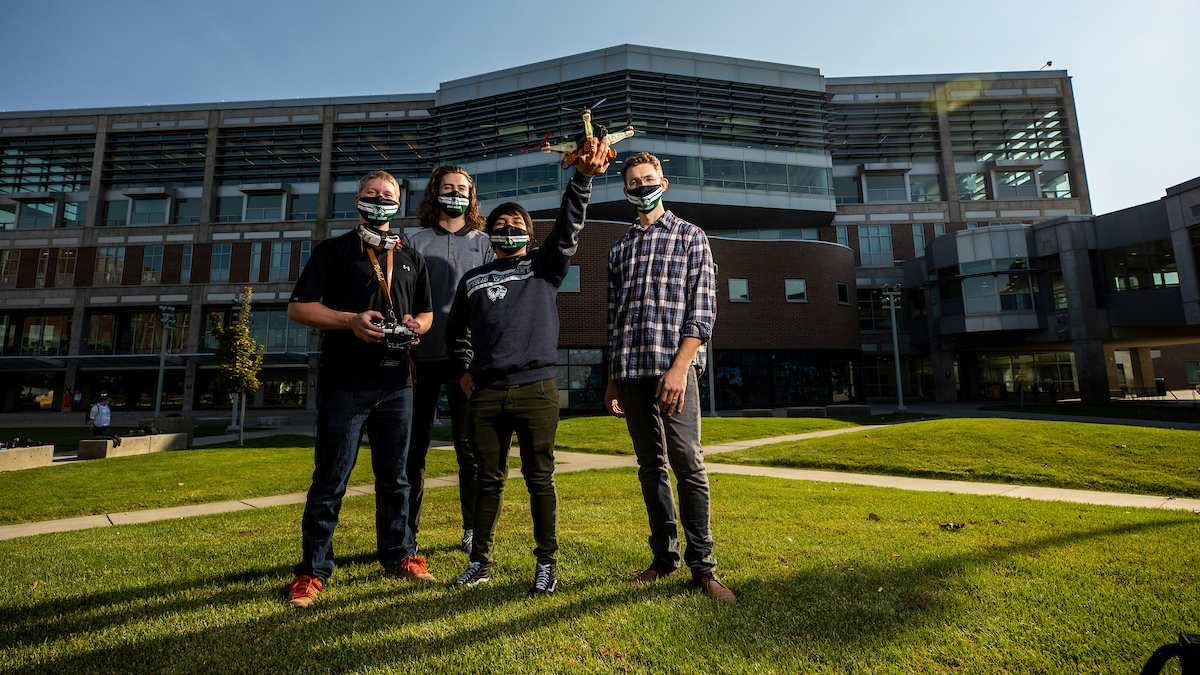For the second straight year, a team of UVU students won the ASME IAM3D Unmanned Aerial Racing Cargo International Competition.

In late April, Bryce Prestwich, Shawn Weeks, Rodrigo Merino Osorno, and Logan Sanford sat at home anxiously waiting to hear the results of the ASME IAM3D Unmanned Aerial Racing Cargo International Competition. Their drone, affectionately named “Neil,” had just been evaluated virtually. The team, consisting of three UVU seniors and one junior, won the competition last year, and tensions mounted as they wondered whether they could uphold their reputation as national champions.
The event was sponsored by the American Society of Mechanical Engineers and involved a 24-hour livestream awards ceremony. When all was said and done, the presenters announced UVU was the international champion team, making the track record 2-0 for the school, which has placed first both years students have competed in the competition.
“Having won the competition last year, we felt confident. But this year, there were more than 20 entries from schools across the globe, so our team felt pressure to represent UVU coming in as underdogs compared to other universities,” said Logan Sanford, the junior team member who works in UVU’s Prototyping Lab. “When we won, I felt a sense of relief. We had worked so hard on this drone, and for my peers who graduated, it was the pinnacle of their college career.”
UVU’s drone competed against 22 other drones, a significant increase from the previous year since the national competition invited international schools to the 2021 event. According to Sanford, it made the win that much sweeter: “The third-place school, the University of Central Florida, has students who intern at NASA. It was pretty surreal to know that we beat some of those more prestigious schools.”
Building the drone was no easy feat, however. To meet competition requirements, the students had to build a drone using motors, wires, and batteries. The main body of the drone had to be made using 3D printers and fall within a certain weight and size range.
Masood Amin, advisor to the team and professor of mechanical engineering for 31 years at UVU, said that although the team’s drone won the previous year, the team decided to redesign this year’s entry completely. “Last year’s drone had many unique features, but the students wanted to reduce the number of parts this time around,” Amin explained.
According to Sanford, this year’s UVU drone was a bit shorter, had one less motor and a lower center of gravity, and was all printed in one piece. “The whole process took about a month and a half,” he said. “We printed new iterations of the drone every two to three days or so. We also started designing about two months later than most of the other schools, but all of our teammates were working at the time, and some of us have kids.”
Despite timing challenges between work and family, Sanford said the key to success was the cohesiveness of the team: “We really played to each individual’s strengths, and we all excelled in different areas. We had the previous year of working together under our belts, too, and that helped.”
When it came time to submit materials to the virtual competition, the team had prepared a design report and four videos, including a team overview, a breakdown of the drone parts, measurements for the drone course, and footage of the drone in action. The course consisted of pickup and drop-off points where the drone would carry blocks from one destination to another.
Not only was the process an exciting experience, but Sanford believes that it was also a unique opportunity to connect classroom learning to hands-on experience: “Over the last two years, I have learned how to connect theory to industry, and I can put that in my toolbox as I head into my career.”
The back-to-back wins are a compliment to the relatively young engineering program at UVU. “We only started the engineering program in 2018, so this is a tremendous achievement,” Amin said.
With a national and an international win as feathers in their caps, the team members are moving in different directions, ready to take the engineering world by storm. Weeks just started graduate school at the University of Utah and is working under a professor with a NASA grant. Osorno works at Vanderhall as a mechanical engineer and in research and development. Prestwich works as a mechanical engineer for a local company. Sanford, graduating next year, will continue at UVU’s Prototyping Lab and will lead the team next year, with hopes of snatching a third consecutive win for UVU.
This article was originally published in the Provo Daily Herald.